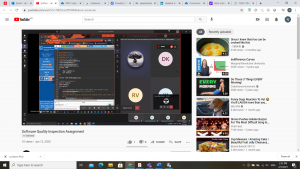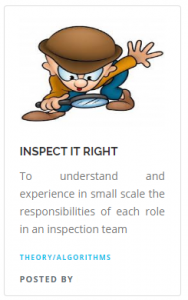 Course overview
Course overview
The course introduces students to the fundamental concepts and principles of software quality. It further emphasizes the importance of ensuring quality in software products and services for being competitive in the software services industry. Topics covered include quality management systems, quality assurance plans, product and process quality models, inspection and walkthrough, software testing, software metrics, and common software quality standards. Upon completion of the course students are able to explain the fundamental concepts associated with quality and software quality, apply appropriate techniques and processes in solving issues related to software quality assurance implementation, and work effectively in a team exercising quality assurance activities.
Participants in piloting
The course is compulsory for students enrolled in the Bachelor in Computer Science Bachelor in Computer Science (Software Engineering) (Hons.) Program at Universiti Tenaga Nasional. The course is included in 2nd year of studies curriculum. On average, a total of 50 – 100 students take the course each semester. It bears 3 credit units, which correspond to a 3 hour lecture each week.
Use of ALIEN services and tools
 Active learning is deployed in the course for building knowledge on software inspection and walkthrough. For this activity, students are assigned a problem to be solved in groups. Each group is comprised of 5 – 6 students. The problem is also uploaded onto the ALIEN digital platform for easy access by participating students. The ALIEN problem further allows the sharing of the problem among instructors.
Active learning is deployed in the course for building knowledge on software inspection and walkthrough. For this activity, students are assigned a problem to be solved in groups. Each group is comprised of 5 – 6 students. The problem is also uploaded onto the ALIEN digital platform for easy access by participating students. The ALIEN problem further allows the sharing of the problem among instructors.
The learning objective of this activity is for the students to build knowledge on the roles involved in an inspection process and the responsibilities of each role. Students are assigned into groups of 4 – 6 individuals for this activity. At the beginning of the session each group is asked to search for an inspection report template used by any software company that they can use to report the inspection activity that they will perform. This activity allows students to understand the expectations from an inspection process and what to look for in an inspection activity. In each group, students assign amongst themselves the roles of moderator, author, reviewer, and scriber. In a group of more than 4 individuals, team members are allowed to allocate an additional reviewer and author in descending priority order. Each student is required to discover the responsibilities of the role he will play during the inspection activity.
Each group is then given a sample program to inspect and the inspection session begins. Each member of the group plays their role to ensure the delivery of each responsibility. Depending on the inspection templates that they have chosen students are required to complete the template with the required information that is obtained by conducting the inspection session. At the end of the activity they are required to submit the inspection report, the inspection meeting minutes, and the full description of each role assumed during the activity. In their submission are asked to provide complete descriptions of the tasks that they perform according the roles assigned. The descriptions of the roles are used by the instructor to assess students’ understanding of the topic and to facilitate discussion during the wrap-up session.
Due to the COVID-19 pandemic, the activity is slightly modified. Students are asked to submit a recording of their inspection session instead. This spares students from preparing a lengthy report and allows the instructor to assess their understanding of the topic.


